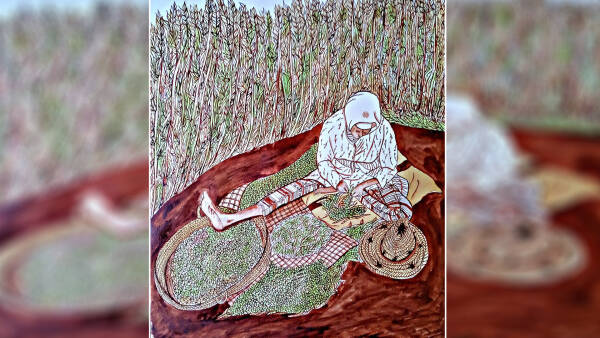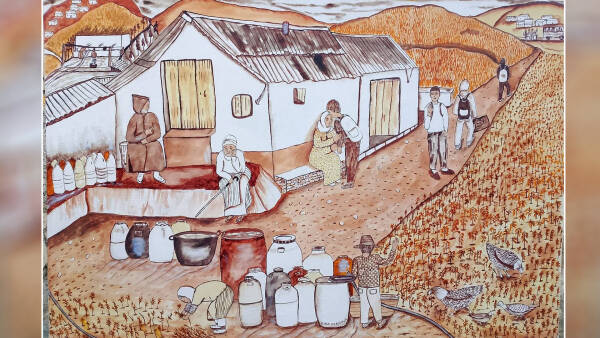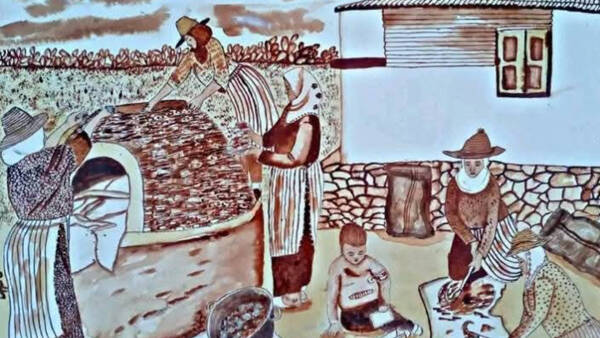A Moroccan Artist Blends Heritage, Innovation, and Struggle Through Her Brush
Zahra Ahnach carries a unique artistic experience, turning painting into her means of expression and resistance. She transformed olive water into ink, the Chefchaouen hat into a flag, and the rural woman into an icon in her paintings.

Hanan Harat
Morocco - Zahra Ahnach represents the model of a rural artist who does not wait for perfect conditions to create but instead crafts her own tools from nature’s resources, turning them into artworks that convey human and cultural messages. From olives to the Chefchaouen hat, and from simple dreams to artistic reality, her story remains a source of inspiration for anyone seeking to blend heritage and innovation in a single canvas.
In the mountains of Chefchaouen, northern Morocco—where olive trees stretch as far as the eye can see—stories are born from the womb of nature. There, in a small village called Douar Aloui, far from the city’s noise, Zahra Ahnach sits in her modest studio wearing the colorful, thread-embroidered Chefchaouen hat. To her, it is not merely a head covering but a declaration of identity, a symbol of belonging to her village, her land, and her roots—all vividly reflected in her artwork.

Painting as an Outlet
Zahra Ahnach is not a graduate of art schools but a self-taught artist who forged her own style through persistence. Since childhood, painting has been her escape after she was forced to leave school early. Her education ended at the sixth grade because the nearest middle school was too far. “I couldn’t accept the idea of leaving school,” she says. “My life suddenly felt empty, so I began expressing myself through simple sketches. But the lack of tools and paint in the village made my first attempts very difficult, and I almost gave up.”
Thirteen years passed before a turning point came in 2018, when Zahra accidentally discovered that the liquid residue from olive pressing—locally called “Al-Marjan”—left a dark trace resembling ink. That’s when an idea struck her: what if I used this water for painting? She collected some and tried it on paper, discovering that nature had offered her a free, organic, and unique pigment unlike any other. Since then, “olive water” has become her secret material—she dips her brush in it, then paints faces and forgotten features from rural women’s lives.
About the color produced by Al-Marjan, she explains that it is naturally dark, similar to black ink, but for her, it represents much more than a color:
“Some may think one color is limiting, but for me, it’s freedom—it allows me to focus on the idea, the light and shadow, and the message I want to convey.”

Reviving the Hidden Features of the Countryside
When asked about the themes she focuses on, Zahra says her work is mainly inspired by women—especially rural women deprived of basic rights like education and participation in public life. “Every success I achieve, I consider it a success on behalf of all rural women,” she adds. “My paintings say that the rural woman can create art, even from simple things like olive water.”
Zahra’s art does not focus solely on women; she also strives to preserve the traditions of her region and record them as a visual memory for future generations. In one of her paintings, for example, a woman appears wearing the traditional Chefchaouen attire, surrounded by symbols of daily village life. In others, one can glimpse scenes of northern Morocco’s landscapes—or references to Palestine, a cause Zahra considers “the cause of every free human being.”
“Sometimes I stop everything just to paint Palestine,” she says. “I feel I cannot work on anything else while Palestine is bleeding.”

Persevering Despite Challenges
Zahra’s artistic journey has not been without challenges. The lack of institutional support for artists in Morocco, she explains, makes the road difficult. “Even the artist’s card doesn’t mean much; support is weak,” she says. Yet, she refused to give up. By sharing her work on social media, she found wide engagement from local and international audiences, including artists who admired her unique approach. This encouragement motivated her to keep refining her style.
As for her dream, Zahra Ahnach says it is “simple but profound”: “That rural women get the chance to learn and receive vocational training, and that visual art be seen as more than just a trade—but as a human message. I hope artists, especially women, will be given the recognition they deserve.”
